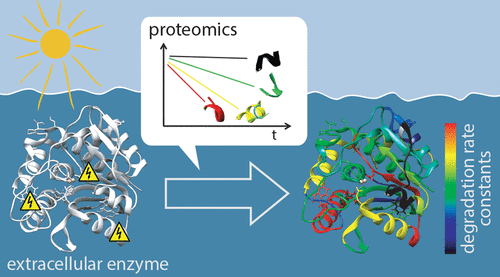当前位置:
X-MOL 学术
›
Environ. Sci. Technol.
›
论文详情
Our official English website, www.x-mol.net, welcomes your
feedback! (Note: you will need to create a separate account there.)
Proteomics Approach To Trace Site-Specific Damage in Aquatic Extracellular Enzymes During Photoinactivation
Environmental Science & Technology ( IF 10.8 ) Pub Date : 2018-07-05 , DOI: 10.1021/acs.est.7b06439 Christine M. Egli 1, 2 , Elisabeth M.-L. Janssen 2
Environmental Science & Technology ( IF 10.8 ) Pub Date : 2018-07-05 , DOI: 10.1021/acs.est.7b06439 Christine M. Egli 1, 2 , Elisabeth M.-L. Janssen 2
Affiliation

|
Extracellular enzymes are major drivers of biogeochemical nutrient and carbon cycling in surface water. While photoinactivation is regarded as a major inactivation process of these enzymes, the underlying molecular changes have received little attention. This study demonstrates how light exposure leads to a rapid loss of phosphatase, aminopeptidase, and glucosidase activities of biofilm samples and model enzymes. Here, an optimized proteomics approach allowed simultaneous observation of inactivation and molecular changes. Site-specific fingerprints of degradation kinetics have been generated and visualized in the three-dimensional proteins. Oxidation of tryptophan, the chromophoric target, initiated secondary reactions. Evidence was obtained that tyrosine residues act as intramolecular antioxidants, reflected in decelerated decay of tryptophan-containing peptides and enhanced decay of tyrosine-containing peptides. In addition, subsequent methionine oxidation and disulfide reduction contribute to heterogeneous photodamage. The proximity to tryptophan residues explains >95% of the photodamage across the protein structures. The presence of redox active organic matter or a model antioxidant in solution quenched not only photoinactivation and tryptophan oxidation but also all subsequent damage. The developed analytical approach can be applied to other research questions in environmental sciences where site-specific damage in a protein is essential.
中文翻译:

蛋白质组学方法在光灭活过程中追踪水生细胞外酶中特定于位点的损伤
细胞外酶是地表水中生物地球化学养分和碳循环的主要驱动力。尽管光灭活被认为是这些酶的主要失活过程,但潜在的分子变化却鲜有受到关注。这项研究证明了曝光如何导致生物膜样品和模型酶的磷酸酶,氨基肽酶和葡萄糖苷酶活性快速丧失。在这里,优化的蛋白质组学方法可以同时观察灭活和分子变化。降解动力学的位点特异性指纹已经生成并在三维蛋白质中可视化。色氨酸(发色目标)的氧化引发了次级反应。酪氨酸残基充当分子内抗氧化剂的证据,反映为含色氨酸的肽的衰变减速和含酪氨酸的肽的衰变增强。另外,随后的蛋氨酸氧化和二硫化物还原也造成了非均质的光损伤。色氨酸残基的接近性解释了蛋白结构中95%以上的光损伤。溶液中氧化还原活性有机物或模型抗氧化剂的存在不仅淬灭了光灭活和色氨酸氧化,而且还淬灭了所有随后的破坏。所开发的分析方法可以应用于环境科学中其他研究问题,其中蛋白质中的位点特异性损伤至关重要。色氨酸残基的接近性解释了蛋白结构中95%以上的光损伤。溶液中氧化还原活性有机物或模型抗氧化剂的存在不仅淬灭了光灭活和色氨酸氧化,而且还淬灭了所有随后的破坏。所开发的分析方法可以应用于环境科学中其他研究问题,其中蛋白质中的位点特异性损伤至关重要。色氨酸残基的接近性解释了蛋白结构中95%以上的光损伤。溶液中氧化还原活性有机物或模型抗氧化剂的存在不仅淬灭了光灭活和色氨酸氧化,而且还淬灭了所有随后的破坏。所开发的分析方法可以应用于环境科学中其他研究问题,其中蛋白质中的位点特异性损伤至关重要。
更新日期:2018-07-08
中文翻译:

蛋白质组学方法在光灭活过程中追踪水生细胞外酶中特定于位点的损伤
细胞外酶是地表水中生物地球化学养分和碳循环的主要驱动力。尽管光灭活被认为是这些酶的主要失活过程,但潜在的分子变化却鲜有受到关注。这项研究证明了曝光如何导致生物膜样品和模型酶的磷酸酶,氨基肽酶和葡萄糖苷酶活性快速丧失。在这里,优化的蛋白质组学方法可以同时观察灭活和分子变化。降解动力学的位点特异性指纹已经生成并在三维蛋白质中可视化。色氨酸(发色目标)的氧化引发了次级反应。酪氨酸残基充当分子内抗氧化剂的证据,反映为含色氨酸的肽的衰变减速和含酪氨酸的肽的衰变增强。另外,随后的蛋氨酸氧化和二硫化物还原也造成了非均质的光损伤。色氨酸残基的接近性解释了蛋白结构中95%以上的光损伤。溶液中氧化还原活性有机物或模型抗氧化剂的存在不仅淬灭了光灭活和色氨酸氧化,而且还淬灭了所有随后的破坏。所开发的分析方法可以应用于环境科学中其他研究问题,其中蛋白质中的位点特异性损伤至关重要。色氨酸残基的接近性解释了蛋白结构中95%以上的光损伤。溶液中氧化还原活性有机物或模型抗氧化剂的存在不仅淬灭了光灭活和色氨酸氧化,而且还淬灭了所有随后的破坏。所开发的分析方法可以应用于环境科学中其他研究问题,其中蛋白质中的位点特异性损伤至关重要。色氨酸残基的接近性解释了蛋白结构中95%以上的光损伤。溶液中氧化还原活性有机物或模型抗氧化剂的存在不仅淬灭了光灭活和色氨酸氧化,而且还淬灭了所有随后的破坏。所开发的分析方法可以应用于环境科学中其他研究问题,其中蛋白质中的位点特异性损伤至关重要。











































 京公网安备 11010802027423号
京公网安备 11010802027423号